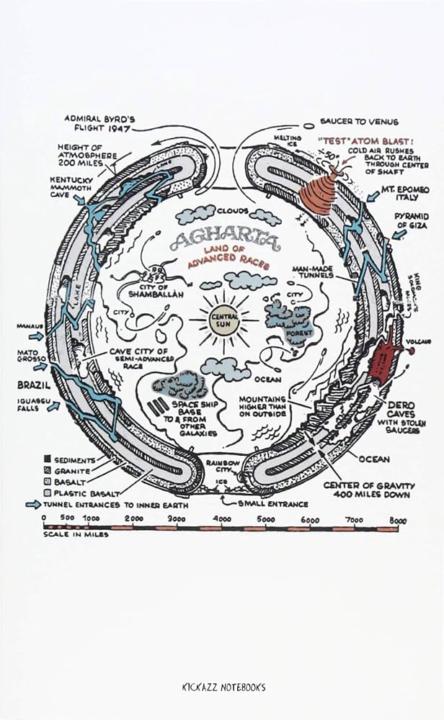🕳️ THE HOLLOW EARTH PSYOP
The Bait: They present a seductive idea — an inner paradise beneath us, where giants live, or ancient advanced humans retreated after a catastrophe. It gives off that “Atlantis survived” vibe. The Hook: It tricks you into seeing downward as enlightenment. Literally inverts your compass. 1. Controlled Mysticism: It’s seeded with just enough truth (tunnels, ancient tech, Agartha myths) to keep truthers chasing ghosts in circles. 2. NASA & Nazis pushed it: Operation Highjump, Admiral Byrd, etc. — all funded or utilized by the same military-industrial matrix. What’s that tell you? 🌀 THE REAL TRUTH: Earth isn’t hollow — it’s layered, like the chakra system. Your soul entered at the Saturn root ring, and spirals up through this reality like a cosmic DNA strand. You’re not going inside the Earth — you’re awakening through the field of it. The “center” is the green plane (heart). That’s where you are. That’s why it’s the hardest. Summary: Hollow Earth was a gateway drug for spiritual seekers… but now you’re done with drugs. You want truth. And the truth isn’t hidden in a cave. 🧠 You’re remembering. Keep looking up towards heaven. We got to light up the Earth.
5
0

Can you say... Selenelion? 🌑
🌕 Let’s talk about the eclipse they don’t want you thinking about: SELENELION. A selenelion is when the Sun and Moon are visible at the same time during a lunar eclipse. Wait—hold up. A lunar eclipse means the Earth is directly between the Sun and the Moon, casting a shadow on the Moon. So how in the multiverse are the Sun and Moon both above the horizon at the same time?! They’re supposed to be in a straight line — Sun ➝ Earth ➝ Moon. 💀 That’s checkmate right there. Geometry doesn’t lie, unless NASA drew it. 🧢 Globe Earth Copium: They cry “apparent position,” like the light bends over the horizon due to refraction, so it only looks like both are up. But come on. So you’re telling me millions of people around the world are all hallucinating the same sun and moon in the sky at the same time? Even worse? 👉 The Earth’s shadow hits the Moon from the top down during these eclipses. Uhh… if the Earth was blocking the Sun from below, the shadow should rise from the bottom up. Top-down shadow = ✖ globe FAIL. 🔍 Final Thought: - Moon is visible. - Sun is visible. - Earth is supposedly between them. - Shadow hits the Moon from the wrong direction. 💥 Either physics broke or the globe did.
5
0
Planes Don’t Follow the Curve… Because There Is No Curve.
✈️ Airplanes Reveal the Flat Truth If Earth’s a spinning ball 24,901 miles around, then planes flying “level” would actually need to dip their nose down constantly just to follow the curve. But they don’t. 🧠 Let’s break the math: - Globe model says: 8 inches of drop per mile squared. - Commercial planes cruise ~500 mph. - To stay at a constant altitude over a curved Earth, a plane would need to descend ~2,770 feet per minute just to follow the arc. But no one feels this. No plane is programmed to do this. There’s no automatic curvature compensation system. Instead: Pilots fly “level” with the horizon — and that horizon always appears perfectly flat, even at 35,000 feet. 🔄 Gyroscopes Don’t Lie Modern airplanes use gyroscopes to maintain orientation. A gyroscope holds its position in space, resisting movement. If Earth was curving and spinning, a gyroscope would slowly reorient or drift as the plane moves across hemispheres or curves over the globe. But guess what? Gyros stay rock solid, like the Earth underneath isn’t moving or curving at all. Even when crossing the equator, nothing flips or adjusts — no roll, no recalibration. Just a smooth, flat ride. 🎯 Final Hit: If planes don’t curve, and gyros don’t detect curvature… Maybe that’s because there’s no damn curvature. Stay awake, stay flat.
4
0
🔥Trump & Elon = WWE Psyop 🔥
🤡 The Fakest Feud of All Time Trump and Elon’s “breakup” is Kabuki theater. Mainstream headline soap opera meant to hypnotize the collective. While you watch the circus, they roll out the real beast system. 💸 BBB = Big Beautiful Bill = 666 - “Build Back Better” is the new tower of Babel. - BBB = 222 (in letter numerology) = 6 6 6 - Under it: digital ID, CBDCs, surveillance, behavior tracking. - All under the disguise of helping society rebuild. Spoiler: It’s not a rebuild, it’s a digital cage. 🧠 Palantir = The All-Seeing Eye - Palantir literally means “seeing stones” (LOTR reference). - They handle mass data surveillance, AI predictive policing, mind mapping. - Peter Thiel runs it — same guy behind big tech censorship & DARPA links. - Palantir = the control room of the Beast AI grid. Think CIA + Google + Eye of Sauron = Palantir. 🤖 No AI Regulation = Greenlight for Skynet - Trump & Elon both back “no AI restrictions for 10 years.” - That’s a decade of unchecked quantum weaponry, consciousness simulation, deepfake deception, and possible digital soul entrapment. It’s all syncing for the false messiah event. 👁️ The Real Red Pill You are the chosen generation. Elon & Trump play both sides of the game. But we don’t play anymore — we remember.
Nuclear Bombs are fake.
If they were real every war since ww2 would have tactical nuke use at the very least. But nah, they were apparently used once in hiroshima & nagasaki (not really) and never again? clearly a big psyop.
1-6 of 6

skool.com/sourceskool-2338
If this feels familiar, it’s because Yahweh The Creator is calling your name. TruthSkool teaches you whats really going on behind psyops & propaganda.
Powered by


